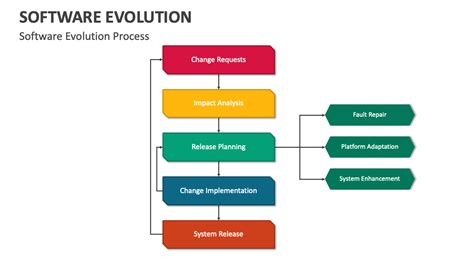"The Evolution of Software Development: Past, Present, and Future"

This blog post explores the evolution of software development, tracing its journey from rudimentary beginnings to the sophisticated practices of today. We begin with the early days, examining the genesis of software development and the challenges faced. Then, we delve into the transformative impact of Agile and DevOps methodologies, which revolutionized development workflows. The article further discusses how cloud computing has reshaped the software landscape, providing scalability and accessibility. Finally, we look ahead to the future, focusing on the pivotal role of AI and automation in driving the next stage of software development’s continuous evolution.
Early Days: The Genesis Of Software Development
The story of software development is a fascinating journey from theoretical concepts to practical applications that have revolutionized our world. In the early days, the evolution of software was closely tied to the advancement of hardware. The first programs were not what we would recognize today; they were often hardwired or required manual input through switches and punch cards. These initial efforts laid the groundwork for the complex systems we rely on today.
One of the pivotal moments in early software development was the emergence of high-level programming languages. FORTRAN, developed in the 1950s, allowed programmers to write code in a more human-readable format, which was then translated into machine code. This abstraction was a significant step forward, making software development more accessible and efficient. Following FORTRAN, COBOL emerged as a dominant language for business applications, solidifying the role of software in commercial enterprises.
Here’s a look at how programming languages evolved in the early days:
| Language | Year Introduced | Primary Use |
|---|---|---|
| FORTRAN | 1957 | Scientific and engineering calculations |
| COBOL | 1959 | Business applications |
| ALGOL | 1958 | Algorithm development and education |
| BASIC | 1964 | Beginner-friendly programming |
Early software development was also characterized by the rise of operating systems. These systems managed hardware resources and provided a platform for running other software. IBM’s OS/360 was a landmark achievement, offering a standardized environment for a range of applications. The development of operating systems marked a crucial shift towards more sophisticated and versatile computing environments.
Here are some of the key milestones that defined the early days of software development:
- 1940s: Development of the first electronic computers like ENIAC and Colossus.
- 1950s: Emergence of high-level programming languages such as FORTRAN and COBOL.
- 1960s: Introduction of operating systems like IBM’s OS/360, enabling more complex software applications.
- Late 1960s: The birth of the Internet, which began as ARPANET, setting the stage for networked software applications.
- 1970s: The rise of personal computing, leading to the development of software for a broader audience.
As software development evolved, so did the methodologies and practices surrounding it. Early methods were often ad-hoc and informal, but as projects grew in complexity, the need for more structured approaches became apparent. The waterfall model, with its sequential phases, gained prominence as a way to manage large projects. While it had limitations, it represented an important step towards more disciplined software engineering. These foundational developments set the stage for the transformative methodologies like Agile and DevOps that would emerge later.
Agile And DevOps: Transforming Development Methodologies
The shift from traditional, waterfall methodologies to Agile and DevOps represents a significant leap forward in software development. This transformation is driven by the need for faster delivery cycles, improved collaboration, and continuous feedback. In essence, Agile and DevOps are not just methodologies; they are cultural shifts that prioritize adaptability and efficiency. This section explores how these practices have reshaped the software development landscape, emphasizing the evolution of collaborative and iterative approaches.
Understanding Agile Principles
Agile methodologies are centered around iterative development, where requirements and solutions evolve through collaboration between self-organizing, cross-functional teams. The Agile Manifesto highlights values such as individuals and interactions over processes and tools, working software over comprehensive documentation, customer collaboration over contract negotiation, and responding to change over following a plan. These principles emphasize flexibility and customer satisfaction, enabling teams to adapt quickly to changing requirements.
Agile methodologies have transformed how software development teams operate. Here’s a table summarizing key differences between Agile and traditional Waterfall methods:
| Feature | Agile | Waterfall |
|---|---|---|
| Approach | Iterative and Incremental | Sequential and Linear |
| Flexibility | Highly flexible and adaptable | Limited flexibility |
| Customer Involvement | Continuous customer involvement | Customer involvement primarily at the beginning and end |
| Risk Management | Risks are identified and mitigated early | Risks are often identified late in the process |
Implementing DevOps Practices
DevOps extends Agile principles by integrating development and operations teams to streamline the software delivery pipeline. It emphasizes automation, continuous integration, continuous delivery (CI/CD), and continuous monitoring to ensure rapid and reliable releases. DevOps is about breaking down silos between teams and fostering a culture of shared responsibility.
Successfully implementing DevOps requires careful planning and execution. Consider the following steps when introducing DevOps practices:
- Assessment and Planning: Evaluate current processes and define clear goals.
- Automation: Automate repetitive tasks to reduce errors and speed up delivery.
- Continuous Integration: Integrate code changes frequently to detect and resolve issues early.
- Continuous Delivery: Ensure software can be reliably released at any time.
- Monitoring and Feedback: Implement monitoring tools to track performance and gather feedback.
- Cultural Shift: Foster a collaborative culture between development and operations teams.
Benefits of Agile and DevOps
The combined adoption of Agile and DevOps practices yields significant benefits, including faster time to market, improved software quality, increased customer satisfaction, and enhanced team collaboration. Organizations that embrace these methodologies are better equipped to respond to market demands and deliver innovative solutions.
Agile and DevOps enhance software development in numerous ways, leading to significant improvements in efficiency and quality. According to industry reports:
Companies adopting DevOps practices experience up to 20x more frequent deployments and a 50% reduction in lead time.
Ultimately, Agile and DevOps represent a transformative shift in software development, fostering collaboration, automation, and continuous improvement. As the industry continues to evolve, these practices will remain central to delivering high-quality software efficiently.
Cloud Computing: Reshaping The Software Landscape
Cloud computing has revolutionized numerous industries, and software development is no exception. By providing on-demand access to computing resources, cloud platforms have significantly altered the way software is designed, developed, tested, and deployed. This shift has not only enhanced efficiency but also fostered innovation and collaboration within development teams. Cloud-based services offer scalable infrastructure, allowing developers to quickly adapt to changing project demands without the upfront costs and maintenance overhead associated with traditional hardware.
| Feature | Traditional Development | Cloud-Based Development |
|---|---|---|
| Infrastructure | On-premise servers | Cloud-based servers |
| Scalability | Limited, requires hardware upgrades | Highly scalable, on-demand resources |
| Collaboration | Often siloed, complex | Seamless, integrated tools |
| Cost | High upfront costs, maintenance | Pay-as-you-go, reduced overhead |
The introduction of cloud computing has profoundly impacted the evolution of software development, enabling faster development cycles and improved software quality. Developers can now leverage a wide range of pre-built services and tools offered by cloud providers, such as Amazon Web Services (AWS), Microsoft Azure, and Google Cloud Platform (GCP). These services include databases, machine learning APIs, and serverless computing options, allowing developers to focus on writing code rather than managing infrastructure. The agility and flexibility of cloud environments have become essential for modern software development practices.
- Benefits of Cloud Computing for Software Development
- Reduced infrastructure costs and maintenance.
- Enhanced scalability and resource allocation.
- Improved collaboration and communication among team members.
- Faster deployment and release cycles.
- Access to a wide range of development tools and services.
- Increased agility and flexibility in adapting to changing requirements.
Moreover, cloud computing promotes a more collaborative and integrated development environment. Cloud-based tools facilitate seamless communication and code sharing among team members, regardless of their geographical location. Version control systems, project management platforms, and integrated development environments (IDEs) hosted in the cloud enable real-time collaboration, code reviews, and continuous integration/continuous deployment (CI/CD) pipelines. This collaborative approach not only accelerates the development process but also improves the overall quality and reliability of the software.
In conclusion, cloud computing has fundamentally reshaped the software landscape by offering scalable, cost-effective, and collaborative development environments. The ability to leverage cloud-based services and infrastructure has empowered development teams to innovate faster, deliver higher-quality software, and adapt to the ever-changing demands of the digital age. As cloud technologies continue to evolve, their role in the evolution of software development will undoubtedly become even more significant.
AI And Automation: The Evolution Of Future Software
Artificial Intelligence (AI) and automation are poised to revolutionize software development, marking a significant leap in the evolution of how software is created, tested, and deployed. These technologies promise to enhance efficiency, reduce errors, and enable developers to focus on more strategic and creative aspects of their work. As AI algorithms become more sophisticated, they can automate repetitive tasks, analyze code for vulnerabilities, and even generate code snippets, thereby accelerating the development lifecycle and improving software quality. This shift is not just about automating existing processes; it’s about fundamentally changing the way software is conceived and built.
| Technology | Application in Software Development | Benefits |
|---|---|---|
| AI-Powered Code Generation | Automatically generating code based on specifications | Faster development, reduced manual coding |
| Automated Testing | Using AI to create and execute test cases | Improved test coverage, early bug detection |
| Intelligent Debugging | Analyzing code to identify and suggest fixes for errors | Reduced debugging time, improved code quality |
| Predictive Analytics | Forecasting project timelines and resource needs | Better project management, reduced risks |
The integration of AI and automation also allows for more intelligent and adaptive software systems. AI can be used to monitor software performance in real-time, identify potential issues, and automatically adjust configurations to optimize performance. This proactive approach to software maintenance ensures that applications remain stable and responsive, even under changing conditions. Furthermore, AI-driven analytics can provide valuable insights into user behavior, enabling developers to tailor software features and functionality to better meet user needs. This level of personalization and responsiveness was simply not possible with traditional software development methodologies.
Actionable Steps for Embracing AI and Automation
- Invest in AI Training: Provide developers with training on AI and machine learning concepts.
- Automate Repetitive Tasks: Identify and automate mundane tasks like code reviews and testing.
- Implement AI-Powered Tools: Integrate AI-driven tools for code generation, debugging, and testing.
- Monitor Software Performance: Use AI to monitor software performance and identify potential issues.
- Encourage Experimentation: Foster a culture of experimentation with AI and automation technologies.
However, the adoption of AI and automation in software development is not without its challenges. Concerns about job displacement, the need for new skills, and the potential for bias in AI algorithms must be addressed. It’s crucial for organizations to invest in training and upskilling programs to prepare their workforce for the changing landscape. Ethical considerations surrounding the use of AI in software development, such as ensuring fairness and transparency, must also be carefully considered. Despite these challenges, the potential benefits of AI and automation are undeniable, and organizations that embrace these technologies will be well-positioned to thrive in the future.
In conclusion, AI and automation are transforming the evolution of software development, offering unprecedented opportunities to improve efficiency, quality, and innovation. By embracing these technologies and addressing the associated challenges, organizations can unlock new levels of productivity and create software systems that are more intelligent, adaptive, and responsive to user needs. As AI continues to evolve, its role in software development will only become more prominent, shaping the future of how software is created and maintained.



